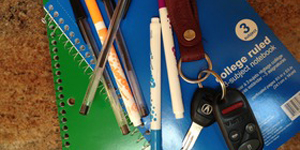Back to School Driving Tips
Early mornings, school buses, kids dashing through the parking lots, and fall weather can provide more challenges for the new driver. If you’re driving to school, here are some of our best tips to keep you and others safe.
Catching ZZZ’s
Are you a teen who is a late owl—playing video games, texting friends, surfing the web, or watching movies on tablets into the wee hours? If this is your schedule, getting up early the next day for school can lead to the inevitable battle with mom or dad for “5 more minutes”. Many high schools schedule students for the early shift—and that means teen drivers are hitting the road at 6:30-7:30 A.M. Make sure you go to bed early enough to get 7-8 hours of sleep. Try to unplug from all your devices at least an hour before bedtime to relax and fall asleep faster. If you’re well rested you’ll be a better driver–and do better at school as well.
Drowsy driving can be just as risky as driving intoxicated. Check for drowsiness if driving back from sports practices or after school activities—you may be more tired than you think. If you’re too tired to drive, don’t. Take a break, sit in your car and rest for a few minutes, have some water or a caffeinated drink, or better yet, if possible, call a parent to come pick you up.
Watch out for those School Buses
In the US, it’s illegal to pass a school bus that is stopped loading or unloading children. Traffic on both sides of the road must stop for a stopped school bus on an undivided road. Check your state laws on what to do on a divided highway, since the laws differ in some states. Be careful driving by areas where other kids are waiting for or exiting a school bus—both at school and in your neighborhood and on the way to and from your school. Kids are darting in and out during loading and unloading time. If possible, come in and leave by a different entrance where you will miss the buses all together.
Driving around Schools
Observe the reduced speed limits around schools. Check posted limits and flashing signs during school hours. Also, obey school safety patrols and crossing guards’ directions. There are also a lot of other new drivers in the school parking lots–so pay extra attention to the other drivers as well as distracted walkers to stay clear of accidents.
Seat Belts
Wear your seat belt every time you get into the car and make sure all passengers buck up as well.
Beware of Distracted Driving
Avoid using your cell phone, texting, fiddling with the radio, eating, drinking, putting on makeup, and talking to friends while driving. They can all take your focus off the road.
Falling Leaves and Wet Roads
Fall brings beautiful changing leaves and sometimes rainy weather. Be careful and allow greater stopping distance when driving on wet leaves and on wet roads which can be slippery.
Keep valuables Hidden
Don’t keep valuables such as cell phones, sports equipment, or expensive clothes or shoes in plain sight in your car where they might be a temptation for theft. Either leave them at home or at least put them in the trunk. Not only will this protect your valuables but also save you the cost of a repairing a smashed in window.
Parking
The student lot is probably a zoo—with rookie drivers rushing to get to class—and zooming out as soon as the last bell rings. Many fender-benders happen in the school lot. A good strategy is to come a little early before the rush—and leave a little late, after most have left. Also, with a double line of spaces, try pulling through a parking space so that your car is facing forward and can pull out without backing out into traffic. Backing up without hitting anything is a skill that comes with a lot of practice. Also practice your skills at reverse parking—backing into a space—so that you’ll also be facing forward when you leave. If you can get a car with a back-up camera, that will be very helpful.
Support Safe Driving
Join—or start a safe driving club at your school. Take the no-texting pledge and have programs to promote safe driving in your community. The more you know, the better driver you’ll be.

